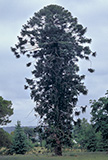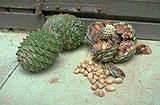|
[Front Page] [Features] [Departments] [SGAP Home Page] [Subscribe]

Bunya Feast
Jan Sked and Chris Macdonald
The Bunya Pine (Araucaria bidwillii) was a rich source of food for the Aborigines of south-east Queensland. Although these trees set cones only once every three years, they are produced in large quantities. Each cone is about the size of a football and contains from 50 to 100 large "nuts".
The Bunya Pine is a large tree, growing 30-45 metres in height, with a straight, rough-barked trunk, and a very distinctive symmetrical, dome-shaped crown. It is an emergent species in subtropical rainforest and is confined to Queensland, where it occurs mainly between Nambour and Gympie and west to the Bunya Mountains, with a small occurrence in north Queensland on Mt. Lewis and at Cunnabullen Falls.
 |
The distinctive shape of Araucaria bidwillii make it one of the most easily recognised of Australia's native trees. Select the thumbnail image or plant name for a higher resolution image (37k).
|
During the Bunya season the Aborigines would temporarily set aside their tribal differences and gather in the mountains for great Bunya Nut Feasts. The aboriginal name for the Bunya Pine was actually "bon-yi" and the Blackall Range, west of the Sunshine Coast, was known to the local Pine Rivers aborigines as the "Bon-yi Mountains". Tom Petrie, was the only free white man to ever attend a bon-yi feast; and it was Tom's father, Andrew Petrie, who discovered this tree around 1838, and who later gave specimens to Mr.John Bidwill, after whom it was ultimately named.
 
Some years ago (late February) members of the Pine Rivers Branch of the Society for Growing Australian Plants gathered under the magnificent century-old Moreton Bay Figs at the North Pine Country Park to enjoy this triennial event. Rollo Petrie (Tom's grandson), our chief cook and provider, had been gathering bunya nuts (thousands and thousands of them) for several weeks prior to this, and had been experimenting with a number of interesting recipes.
By 10.30 a.m. the fire was burning brightly and the billy was on the boil as members began arriving. Proceedings began with a nice "cuppa" - not your ordinary old billy tea, mind you.
This tea was delightfully flavoured with Backhousia citriodora leaves or, for variety, Backhousia myrtifolia.
Morning tea consisted of scones, topped with "jungle" jam (ingredients unknown) or wild raspberry jam plus bunya nut pikelets, bunya nut roll, bunya nut slice, bunya nut bread, bunya bikkies and an interesting little confectionery called Bunya Nut Ice.
 |
When ripe, the large female bunya cone falls from the tree and breaks into segments, each containing a large nut. Select the thumbnail image or highlighted phrase for a higher resolution image (37k). Photo: J.Sked.
|
As lunchtime approached, Rollo stepped up his efforts and produced such delicacies as boiled bunya nuts, roasted bunya nuts, bunya nut casseroles, plus a variety of foods from other members - bunya nut damper, bunya nut spotted dog, bunya and bacon quiche, bunya nut rissoles, bunya nut dessert, and gallons more Backhousia tea.
If you can obtain a supply of bunya nuts, you might like to try one or more of the following.
| Spotted Dog a la Bunya |
Sultanas or mixed fruit
3 cups S.R.flour
2 cups minced Bunya nuts (cooked)
2 tablespoons butter
2 small teaspoons Baking Powder |
2 eggs
1 teaspoon salt
3 tablespoons powdered milk
4 tablespoons sugar |
| Mix flour, powdered milk, salt, baking powder and sugar together. Melt butter in a little hot water. Add minced nuts, eggs, butter and fruit to other ingredients. Mix to just pouring consistency, adding a little more later if necessary. Pour into greased large tray or other suitable baking dish. Bake at 450 degrees Fahrenheit, reduce to 400 after 20 minutes, bake until cooked. | |
| Bunya Johnnie |
4 cups minced Bunya nuts (cooked)
2 eggs
2 teaspoons Baking Powder
2 tablespoons sugar |
2 tablespoons powdered milk
1 tablespoon butter
1/2 teaspoon salt
Fruit if required |
| Mix all dry ingredients together (this includes bunya nuts). Then add eggs and butter which has been melted in a little hot water. Mix to a just-pouring consistency, adding more water if necessary. Pour into greased 7 inch sponge tin. Bake at 450 degrees Fahrenheit for 20 minutes, reduce heat to 400 degrees and bake until cooked. | |
| Bunya Fruit Cake |
3 cups S.R. flour
7 heaped cup raw sugar
3 cups minced Bunya Nuts (cooked)
2 tablespoons butter or
2 teaspoons Baking Powder |
Margarine
1 teaspoon salt
5 eggs
4 tablespoons powdered milk
Fruit to taste |
| Mix all dry ingredients together, add rest with a little water to make mixture to a just-pour consistency. Pour into a greased large lamington tin or other suitable tin. Bake at 450 degrees for 20 minutes, then reduce to 400 degrees and continue baking until cooked. | |
This is a combination of two articles (one by Jan and one by Chris) which originally appeared in the September 1982 and March 1985 issues of the newsletter of the the Queensland Region of SGAP.

[Front Page] [Features] [Departments] [SGAP Home Page] [Subscribe]
Australian Plants online - December 1997
The Society for Growing Australian Plants
|